

Forces Disrupting the Network. Top 10 Strategic Technologies. Digital Trends 2013. Home-automation trend picking up speed. From a cruise ship in the Caribbean, Erik and Ashley Binkowski knew something was awry.
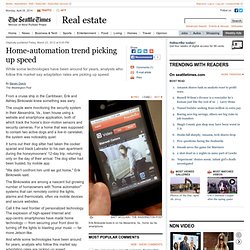
The couple were monitoring the security system in their Alexandria, Va., town house using a website and smartphone application, both of which track the home's door-motion sensors and security cameras. For a home that was supposed to contain two active dogs and a live-in caretaker, the system was noticeably quiet. It turns out their dog sitter had taken the cocker spaniel and black Labrador to his own apartment during the honeymooners' 12-day trip, returning only on the day of their arrival.
The dog sitter had been busted, by mobile app. "We didn't confront him until we got home," Erik Binkowski said. The Binkowskis are among a nascent but growing number of homeowners with "home automation" systems that can remotely control the lights, alarms and thermostats, often via mobile devices and secure websites. Call it the next frontier of personalized technology. Functionality How it works System's cost. Home Tech: Home Automation: The Unfulfilled Promise. Aside from managing simple tasks like lighting and thermostat control, home automation systems haven't taken on much of a role in the household.
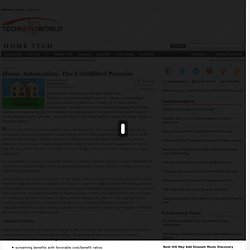
However, as new technologies like home computer networks get a foothold in consumers' homes, and as smart grid technologies gain greater acceptance, home automation systems may reach a tipping point. For the last 30 years, many people have invested a lot of money and effort chasing an unrealized promise of hoped-for explosive growth in home automation. With not a lot of commercial progress, it might be seen as foolish to pursue opportunities in this space. However, the promise of addressing latent needs of the 100 million households in the U.S. -- and the rest of the world -- to create a new consumer electronics (CE) category is highly seductive.
Like so many new opportunities in the CE space, there is a short list of success criteria that must be understood and evaluated. Success Criteria. Statistics to Make You Think. For low-voltage contractors eager to seize more market share in the residential sector, home automation may be where ground can be gained.

A BCC Research study revealed that the U.S. market for home automation systems and devices is expected to see strong growth over the next several years. The market is forecast to exceed $5.5 billion in 2016, the result of a compound annual growth rate (CAGR) of 10.5 percent between 2011 and 2016. In 2010, security systems, home entertainment and lighting made up nearly 58 percent of the country’s residential market, and those sectors are estimated to enjoy a higher CAGR than heating, ventilating and air conditioning and energy management, reaching $3.8 billion by 2016. AT&T to start offering home automation service in March.
AT&T (NYSE: T) is using this week's Consumer Electronics Show in Las Vegas to announce that it will begin delivering its Digital Life home security and automation services to homeowners in eight markets beginning in March.
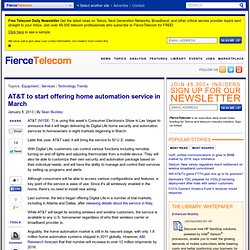
Later this year, AT&T said, it will bring the service to 50 U.S. states. With Digital Life, customers can control various functions including remotely turning on and off lights and adjusting thermostats from a mobile device. They will also be able to customize their own security and automation package based on their individual needs, and will have the ability to manage and control their services by setting up programs and alerts. Sign up for our FREE newsletter for more news like this sent to your inbox! Although consumers will be able to access various configurations and features, a key point of the service is ease of use. Week in research: Enterprise routers struggle globally; home automation a $12B market. Enterprise routers show faint promise: North America sales of enterprise routers were up 8 percent year over year, Infonetics Research reports--a glimmer of hope for a regional market that dropped 10 percent from 4Q 2011 to Q1 2012.

Globally, the market declined 9 percent sequentially to $834 million. Watching the home automation opportunity in 2013. Home automation as we know it has been around for two decades, but in 2013, it may finally come into its own.
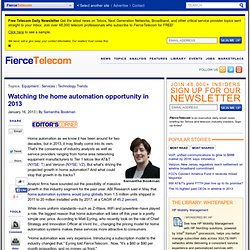
That's the consensus of industry analysts as well as service providers ranging from home area networking equipment manufacturers to Tier 1 telcos like AT&T (NYSE: T) and Verizon (NYSE: VZ). But what's driving the projected growth in home automation? And what could stop that growth in its tracks? Analyst firms have sounded out the possibility of massive growth in this industry segment for the past year. ABI Research said in May that home automation systems would jump globally from 1.5 million units shipped in 2011 to 20 million installed units by 2017, at a CAGR of 45.2 percent. Sign up for our FREE newsletter for more news like this sent to your inbox! The scattered, futuristic world of home automation. A connected refrigerator can, in theory, check your refrigerator for the ingredients you'll need for a particular recipe.
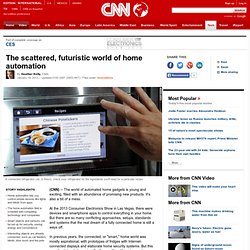
Home automation lets you control simple devices like lights and blinds from appsThe home automation field is crowded with competing technology and companies Smart objects and sensors can be set up for security, saving energy and convenience Interesting objects are already connected, such as cat feeders, blinds, door locks and tea pots (CNN) -- The world of automated home gadgets is young and exciting, filled with an abundance of promising new products. S Wi-Fi-Enabled Security And Automation Products Create A “Connected Home” For Busy Homeowners. LYNX Touch 5100 and Tuxedo Touch™ Wi-Fi Leverage Honeywell’s Legacy in Security, Home Comfort CEA LINE SHOW, NEW YORK (June 27, 2012) – For busy parents who can’t be two places at once, the next best thing is a home that can tell you what’s going on with it, and can be controlled with a smart phone, tablet or other web-enabled device.

A Gamification Framework for Interaction Designers. Gamification is a hot topic.
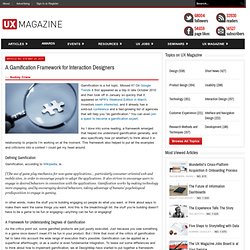
Missed it? Six Sigma. The common Six Sigma symbol Six Sigma is a set of techniques and tools for process improvement.

It was developed by Motorola in 1986.[1][2] Jack Welch made it central to his business strategy at General Electric in 1995.[3] Today, it is used in many industrial sectors.[4] Six Sigma seeks to improve the quality of process outputs by identifying and removing the causes of defects (errors) and minimizing variability in manufacturing and business processes. It uses a set of quality management methods, mainly empirical, statistical methods, and creates a special infrastructure of people within the organization ("Champions", "Black Belts", "Green Belts", "Yellow Belts", etc.) who are experts in these methods. Lean manufacturing. Overview[edit] The difference between these two approaches is not the goal itself, but rather the prime approach to achieving it.
The implementation of smooth flow exposes quality problems that already existed, and thus waste reduction naturally happens as a consequence. The advantage claimed for this approach is that it naturally takes a system-wide perspective, whereas a waste focus sometimes wrongly assumes this perspective. Both lean and TPS can be seen as a loosely connected set of potentially competing principles whose goal is cost reduction by the elimination of waste.[5] These principles include: Pull processing, Perfect first-time quality, Waste minimization, Continuous improvement, Flexibility, Building and maintaining a long term relationship with suppliers, Autonomation, Load leveling and Production flow and Visual control. Origins[edit] Lean aims to make the work simple enough to understand, do and manage. A brief history of waste reduction thinking[edit] 20th century[edit]